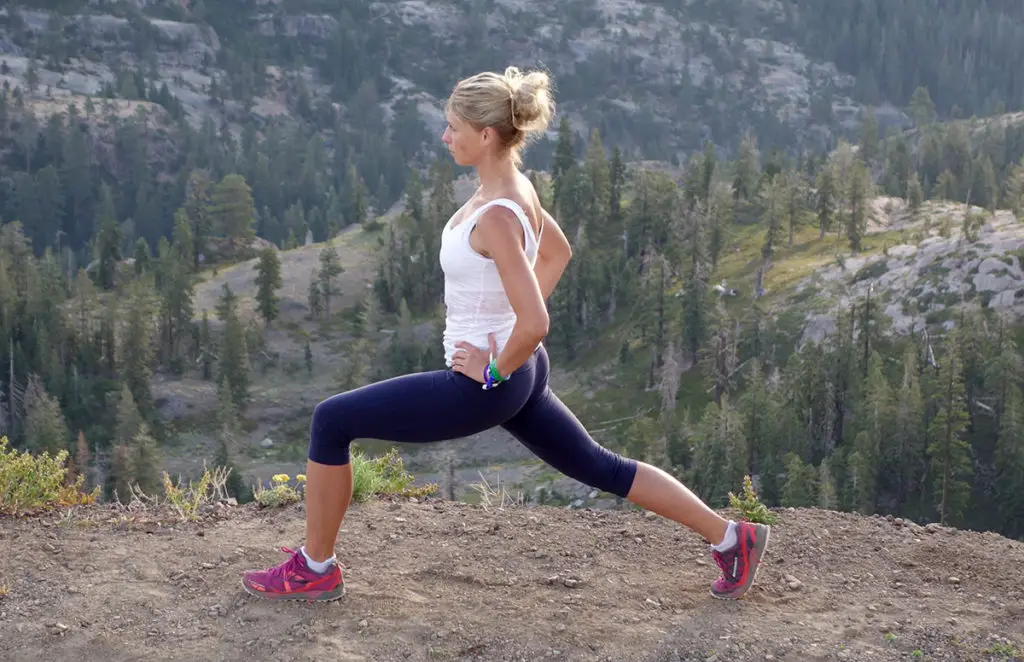Pre Run Yoga – Yoga For Runners (Yoga To Stretch, Increase Capacity, Run, Rest)
Jump To:
Here are pre run yoga, the yoga for runners that help your tired muscles stretch and rejuvenate before you hit the tracks again. Runners, their body needs all the help it can get to recover quickly and effectively. Restful sleep goes a long way in accomplishing this, and so does eating well throughout the day. But even after this, most runners have a bit of tightness and sweet soreness in their bodies.
Runners’ bodies demand a little more than rest and good nutrition to recover well. That is when yoga asanas come to the rescue.
Yoga and running complement each other and yield long-term benefits if practiced together. The right combination of asanas pre-and post-run can loosen muscles and help avoid injuries.
Yoga aids in strengthening and stretching the quad, hamstring, hip flexor, glute, and many other important muscle groups. Pranayama, Surya Namaskar, and similar yoga asanas help regulate breathing and build stamina.
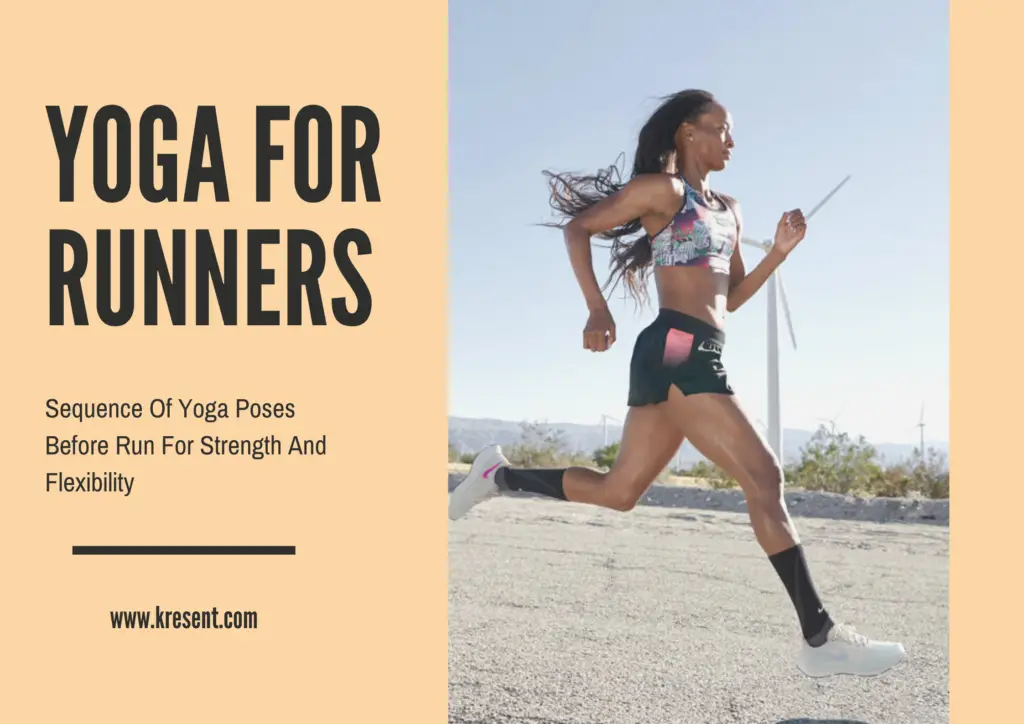
Yoga For Runners – Sequence Of Yoga Poses Before Run For Strength And Flexibility:
Here are some yoga asanas for runners, which provide the deep stretching and flexibility a runner’s body craves before or after a run. A few pre run yoga asanas will help prepare one’s body for a run. They loosen key muscles and help your body ease into running.
1. Tadasana (Standing Pose):
This yoga for runners pose with regular practice opens the upper back, and releases tension from the shoulders. Expand the chest and improve the breath capacity.
It stretches and lengthens all the long muscles of the body, while also opening the spinal, shoulder, and hip joints. This pose strengthens the muscles of the neck, lower back, abdomen, and pelvis. Lung capacity increases and the respiratory muscles become firmer.
Regular practice of this asana not only strengthens the body but also makes it flexible.
Tadasana looks like simple standing but there is a particular way to set every part of the body in the asana. Let’s get into detailed steps of tadasana.

Tadasana Steps:
At first, practice the tadasana with standing against the wall to maintain the correct posture, with hips towards the wall and the ankles a few inches away from it.
- Stand with the feet hip-distance apart grounding the feet. Lift the energy from the ground up towards the torso.
- Gently extend the spine maintaining natural curve, by tucking the tailbone down towards the earth and the pelvis in towards the body.
- Roll the shoulders up towards the ears and drop them down towards the hips. Focus on the breath.
- Inhale; raise the arms up towards the sides, with the shoulders touching the wall, and the palms facing forwards, stretching and extending the torso.
- Exhale; bring the arms down. Repeat 5 to 10 times; relax.
- Inhale; raise both the arms up towards the ceiling with the palms parallel, make sure the shoulders are pressing down towards the hips.
- Exhale; bring the arms down towards the body. Repeat 5 to 10 times; relax.
2. Malasana (The Sumo Pose):
This can truly change the way you use your body as squatting has a deep positive impact on mobility and balance.
Malasana stretches several lower-body major muscle groups.
Strengthens and makes ankles flexible, increases mobility in the hips, stretches the back and soothes back pain.
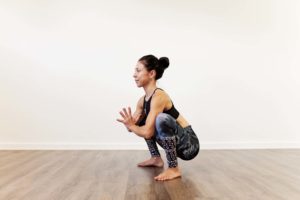
- Squat as deep as you can.
- Push your knees out with your elbows, hold a namaste near your chest, breathe.
3. Vajrasana (Thunderbolt pose):
This is an excellent stretch for your shins, ankles, quads and lower back. Also, calms the mind and body very effectively and is also good for the digestive system.
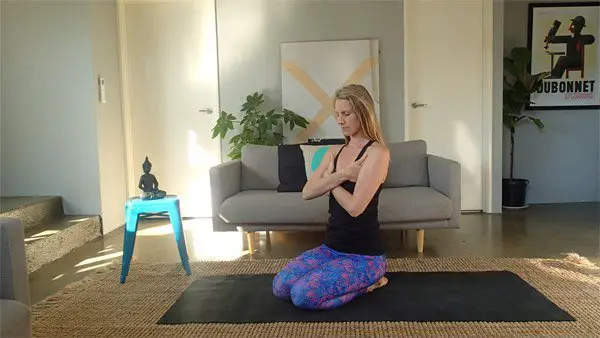
Vajrasana Steps:
- Kneel with the knees closer, stretch out your toes backward and big toes touching each other. (Practice with a blanket under your feet for 30 seconds at a time. You can eventually learn to sit for as long as 20 minutes in this miraculous pose.)
- Place your buttocks in the space between both of your heels separated but big toes touching.
- The spine and head should be straight and relaxed.
- Breath normally closing your eyes and relax the whole body.
Precautions:
If there is an injury in the knee, ankle or shoulder should not attempt this pose.
This asana also lends itself to some nice variations:
You can hold your heels, raise your hips and throw your head back into a camel ( Ustrasana) posture to stretch your abdominals. Sit back again, and this time push your nose to the ground for a deep lower-back stretch in child’s pose ( Balasana).
4. Utthan Pristhasana (Lizard Pose):
This pose not only deep-stretches every muscle in the leg but also provides a huge boost to hip mobility, which leads to an increase in stride length.
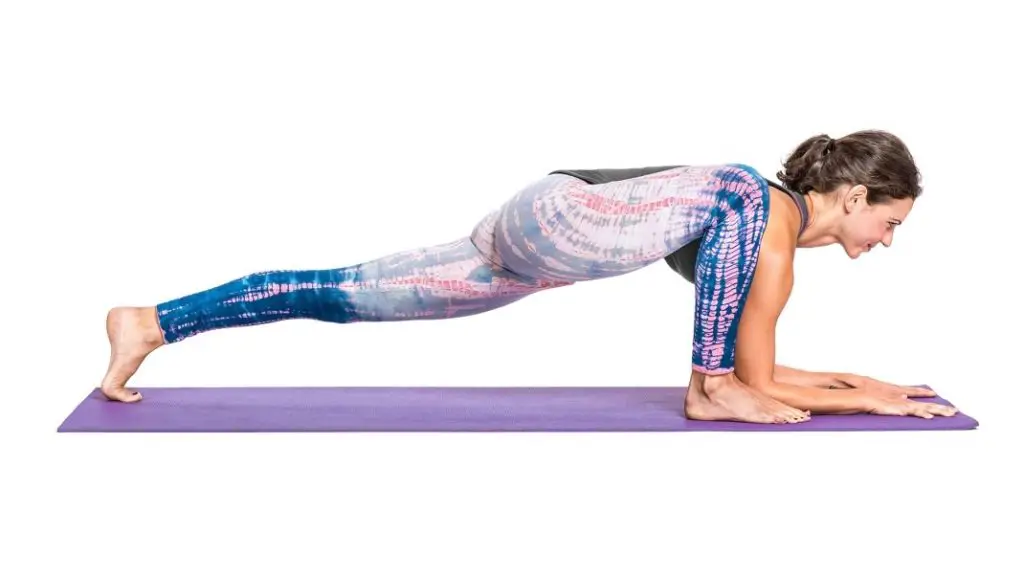
- From plank position, bring a foot forward in an outward arc, place it outside your palm.
- Gradually lower your elbows to the ground, drop the knee outward and raise the neck upward.
- Repeat on the other leg.
5. Kapotasana (Pigeon Pose):
This is a great stretch for the glutes and lower back.
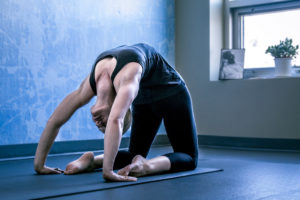
- Start with knees and palms on the ground.
- Bring any one foot forward, send the other foot backward, find a position you feel balanced and stable in.
- Then lower your forehead and arms to the ground.
- Hold this pose while breathing normally, repeat on the other leg.
6. Bhujangasana (Cobra Pose):
This is great for the upper body and lower-spine strength and flexibility.
It stretches muscles in the shoulders, chest and abdominal region. Bhujangasana decreases stiffness of the lower back, strengthens the arms and shoulders, increases flexibility, elevates mood, firms and tones the gluteal muscles, and relieves stress and fatigue. It also opens the chest and helps clear the passages of the heart and lungs and strengthens the spine.
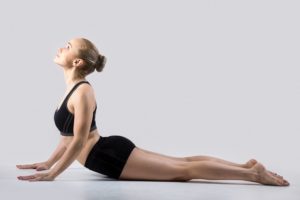
Bhujangasana Steps:
- Lie down on your belly with legs hip distance apart.
- Place your palms a little ahead of your shoulders with elbows on the floor.
- Inhale; internally rotating the thighs in, press the legs down on the floor. See that the toes pressing down with ankles are lifted up.
- Tuck the tailbone down by drawing the pelvis in towards the body.
- Exhale; press the palms into the floor and lift the torso up lengthening it. You’ll see you are squeezing the thighs but make sure you relax the hips muscles.
- Then open the chest wide, with shoulders rolled back down towards hips and away from ears.
Hold this pose for five to ten breaths and then release the pose and rest.
7. Adho Mukha Svanasana (Downward Facing Dog Pose):
It stretches the whole body, builds strength in the arms, legs and feet. It relieves fatigue, rejuvenates the body, improves the immune system, digestion and blood flow to the sinuses, and calms the mind.

Adho Mukha Svanasana Steps:
- Stand on your four limbs like a table with palms placed shoulder-width apart and toes placed hip-width apart parallelly. Tuck your toes inward.
- Exhale; lift the knees off the floor, legs straight and form an inverted V-shape pushing the body weight into the palms and hips up towards the ceiling.
- Attempt to touch your heels to the ground, while keeping your legs straight at the knees.
- Push away from the ground through your palms, keeping your shoulders square and head between your arms. Keep neck neutral and body weight evenly distributed. Touch the ears to the inner arms and sink your hands into the ground.
- Stay in this position and take deep breaths.
Release the pose getting back to table pose bending your knees while exhaling.
8. Setu Bandhasana (Bridge Pose):
It stretches the chest, neck, spine and hips. Strengthens the back, buttocks and hamstrings, and stimulates the lungs, thyroid glands and abdominal organs.
This yoga for runners pose relieves the tension and stress in back muscles instantly. It calms the brain, reducing anxiety, stress, and depression and hence balancing hormones production.
Setu Bandhasana Steps:

- Lie on your back, fold your knees and place your feet hip distance apart on the floor and away from the pelvis.
- Place your palms facing downward beside your body.
- Inhale; slowly lift your lower back, middle back and upper back off the floor gently roll in the shoulders; touch the chest to the chin without bringing the chin down, supporting your weight with your shoulders, arms, and feet.
- Feel your bottom firm up in this pose. Both the thighs are parallel to each other and to the floor.
- Keep breathing easily.
- Stay in this pose for 1-2 minutes.
Release the pose exhaling and lower the hips, lower back and upper back on to the floor gently.
9. Uttakatasana (Chair Pose):
This yoga for runners strengthens the thighs, ankles, calf, shin and knee, stretches the shoulders and tones the abdomen.
This pose strengthens the susceptible Achilles tendon. Beginners are advised to lean against a wall and practice this asana.
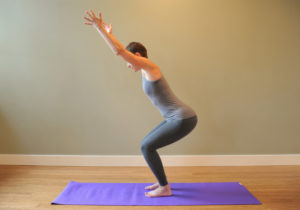
- Stand straight on your mat and place your feet slightly apart.
- Stretch your arms forward, ensuring that your palms are facing downwards. Your arms must be straight, and you must make sure not to bend your elbows.
- Gently bend your knees and push down your pelvis, such that it seems like you are seated in an imaginary chair.
- Make yourself comfortable. To engage better in the pose, imagine reading a newspaper as you hold the pose. And as you do that, you must make sure that your hands are parallel to the floor.
- Be aware as you hold the pose, and keep your spine lengthened. Calm your mind and relax. Smile. Now hold the pose for up to a minute.
- Gently go down and sit in Sukhasana.
Sequence Of Yoga Poses Post-Run For Relaxation:
After a long run, muscles are usually sore and stretching helps relieve tension in the body. Besides stretching key muscles, the following asanas help regulate blood supply and oxygen to the upper parts post run.
10. Viparita Karani (Legs Up The Wall):
This yoga for runners pose drains your legs of all the soreness, has a calming effect due to improved circulation and the inversion does intangible wonders to tired muscles.
It invigorates the entire body and relieves stress and depression. This pose improves blood supply to the abdominal and pelvic organs. It is also beneficial for people with low blood pressure.
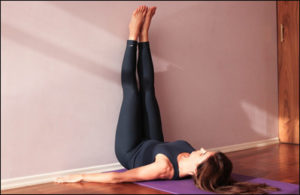
Viparita Karani Steps:
- Sit facing the wall, with the hips a few inches away from the wall.
- Lie down on the spine and raise the legs up on the wall. Make sure that the lower back is touching the floor. If it is not, then place a bolster under the hips.
- Keep the arms a few inches away from the body and open the palms towards the ceiling. Relax the entire body, and stay in this pose for a few minutes.
- To release the pose, bend the knees and drop them down towards the right and then sit up.
Rest in viparita karani pose for five minutes at a time. Do this several times a day.
As a viparita karani variation, sit facing a wall, lower your head to the floor, just raise your legs up the wall. If you are up to it, you can lower your legs behind your head forming a plow.
11. Piraiasana (Half Moon Pose):
Strengthens the spinal cord, revitalizes the nerves and the body becomes active. This pose benefits the heart and regulates high blood pressure. Bending backward gives one room to breathe and this helps the respiratory system.
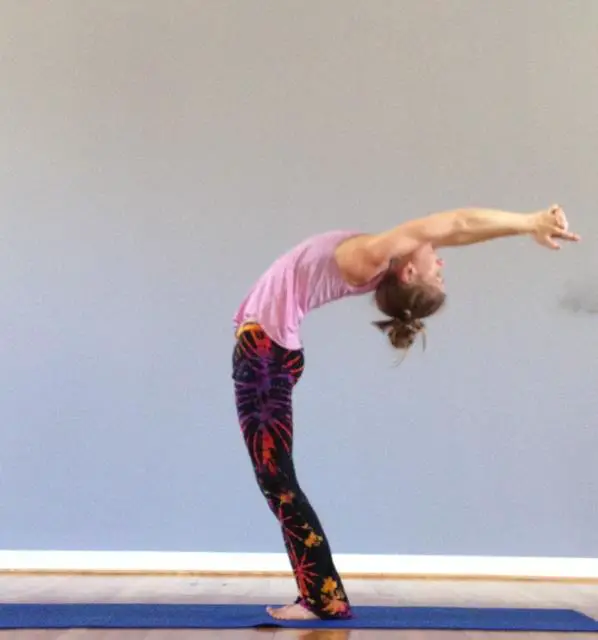
Piraiasana Steps:
- Stand with legs apart, place your hands well below your lower back and bend as far back as possible.
- Hold the position for 15 seconds.
12. Savasana (Corpse Pose):
This posture brings a deep meditative state of rest which helps in the repair of tissues and cells and to release stress.
This pose is best described as alert relaxation. It synthesizes all the actions, instructions and sensations you experience after your yoga practice. Alternatively, it helps in muscle relaxation and inner stillness, while still maintaining energy. Yoga Nidra can fetch you best results on regular practice.
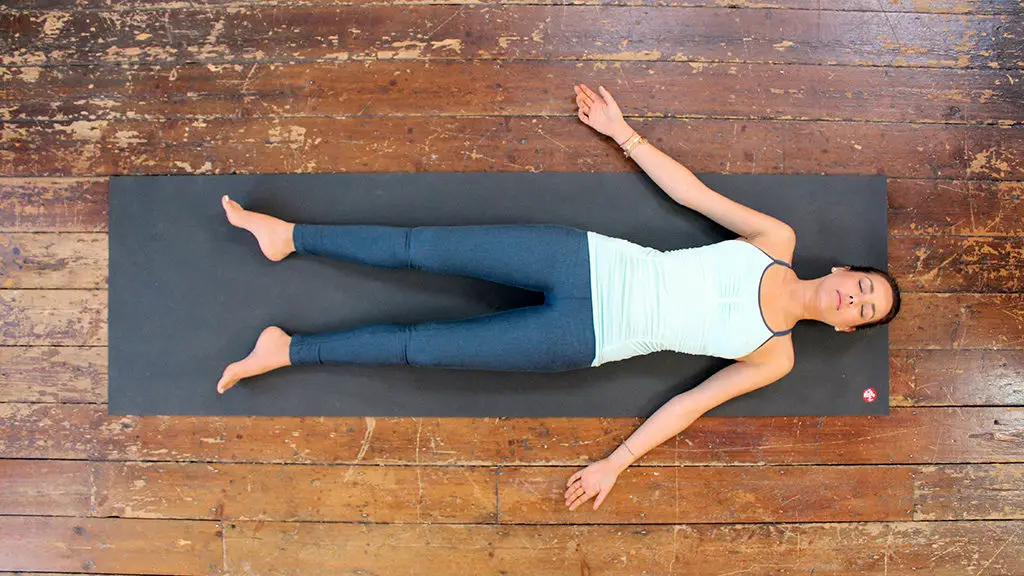
Yoga Nidra Steps:
- Lie down on the floor, legs comfortably apart, arms away from the body.
- Roll the neck from side to side, and back to the center. Make the body as comfortable as possible, so if you need to place a bolster under the knees, do so.
- Once you are in this position, in savasana, avoid movement for the next 20-30 minutes.
- Start to connect to each part of the body, consciously ‘letting go’ and releasing tension from that body part. By doing this, you should be able to release all other thoughts from the mind and focus on the breath.
- Once you have gone through the whole body, gently move the toes and the fingers.
- Roll on to the left side and sit up with the spine straight. Rub the palms together and open the eyes.
Don’t forget to get yourself a pair of good running shoes before you start your run.
FAQs
Is yoga good for runners?
Yoga is the perfect recovery activity for runners. It relieves soreness and tension in your hardworking muscles and restores range of motion so you can run better the next time you hit the road.
Does yoga make you a faster runner?
One of the biggest and most surprising outcomes from yoga is that it can give you a longer running stride. “By encouraging flexibility in the hamstrings and hip flexors, you increase your stride length when you run,” says Lina. “This means you’ll cover the same ground in less time and you’ll run faster.
Does yoga help prevent running injuries?
Yoga helps to prevent injuries by addressing the muscular imbalances created by running and increasing both strength and flexibility. While in the poses, stay focused on your breath and observe your body’s sensations. This helps to build your awareness, which is also key to preventing injuries.
What’s better for runners yoga or pilates?
Many runners cite yoga as the best tool in their training arsenal for preventing injury. Yoga can remedy muscular imbalances, prevent overuse injuries, correct poor running form, and rebuild connective tissue. Beyond injury prevention, Pilates provides an optimal rehabilitation program for injured runners.
How many times a week should runners do yoga?
Whether you’re a newbie or seasoned yogi, Gilman recommends that runners hit their yoga mats two to three times a week.
Is yoga enough strength training for runners?
It’s important to supplement running with yoga and strength training to boost your balance, flexibility, and stability and prevent injury for the long road ahead.
Is Hot Yoga good for runners?
Practicing hot yoga trains your body to rely on its breath for assistance in physical endurance activities – making it an invaluable activity for runners. Foot strength: The balance exercises practiced in hot yoga classes help to strengthen feet, making them more stable and able to stand up to the pressure of running.
Does yoga count as cross-training for runners?
Strength training is crucial for overall health and essential for improving your speed and reducing your injury risk as a runner. Yoga, on the other hand, doesn’t provide a cardiovascular workout and cannot count as specific cross-training (instead, it counts as injury prevention work or mobility work).
